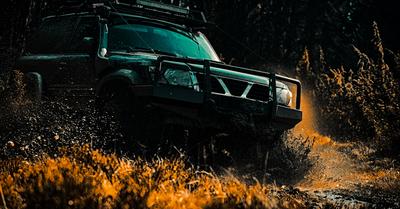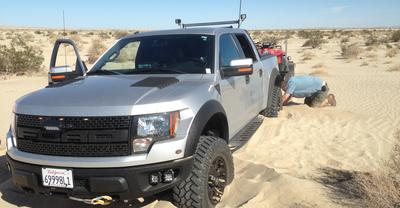Don't let darkness dampen your off-road adventure. Find the best off-road lights for your needs and learn how to choose off-road lights.
To choose the right light, you must consider various factors, such as the light output, terrain type, and mounting position. For example, spot beam lights have a focused lens for high-speed driving, while flood and fog lights cover a wider area to ensure great visibility on foggy or dusty roads.
As an off-road enthusiast myself, I understand the importance of having reliable and high-quality equipment, including quality lights. With years of experience in the industry, I’ve reviewed a wide range of off-road lights, and I have compiled this guide to help you make an informed decision when choosing lights for your off-road adventures. Read on to find more!
Key Takeaways
- Off-road lights can be heavy, so make sure that your vehicle can handle the weight.
- You should also consider the size of the lights and how they will fit on your vehicle.
- Choose a reputable brand. Look for brands with a good reputation in off-roading lights.
- Consider the brightness and color temperature of the lights; the number of lumens.
- Think about the installation process. Some lights require more wiring and installation.
This article may contain affiliate links where we earn a commission from qualifying purchases.
Step-By-Step Guide: How to Choose Off-Road Lights
Choosing the right off-road lights can greatly enhance your off-road experience and safety, but with so many options available, it can be overwhelming to make a decision. Here are some steps to help you choose the right road lighting:
Step 1: Determine Your Needs and Personal Preference
Before you start shopping for off-road lights, it's important to determine your needs. Understanding your needs and preferences will help you choose the right type of off-road lighting. Here are some factors to consider:
1. Off-Roading Needs
Think about the type of off-roading you'll be doing and the conditions you'll be facing. Will you be driving on technical trails like rocky terrain, muddy trails, or in the desert? Do you need light bars that are durable and weather-resistant?
Answering such questions will help determine whether you need fog lights, rock lights, or how durable you want your lights. Also, consider the size and weight of your vehicle and the amount of space you have available for mounting lights.
2. Benefits of Off-Road Lights
Off-road lights offer several benefits, including better visibility and increased safety when driving in low-light conditions.
They also add a stylish touch to your vehicle and can improve its overall appearance. Additionally, off-road lights can be used in emergency situations or when camping in remote areas.
3. Price and Budget
Off-road lights are available at different prices, so it's important to determine your budget before purchasing.
Consider the cost of the lights themselves, as well as any additional installation or wiring costs. Keep in mind that higher-priced lights may offer better quality and durability but may not always be necessary for your specific needs. You can even opt for aftermarket lights that are more affordable.
Step 2: Decide on the Type of Lights You Want
Once you have determined the mounting position for your off-road lights, the next step is choosing the light that will suit your needs.
There are three main types of lights to choose from: halogen, HID, and LED lights. Each type has its advantages and disadvantages, so it's important to understand their differences before making your final decision.
Halogen Lights
Halogen lights are the most common type of off-road light. They are affordable, easy to install, and provide a decent amount of light.
However, halogen bulbs are less bright or efficient than HID light or LED light. Halogen lights also tend to have a shorter lifespan than other types of lights and can be more prone to breaking.
HID Lights
HID lights, also known as xenon lights, are brighter and more efficient than halogen lights. They produce a brighter, whiter light closer to natural daylight, which is why they’re often called white lights.
HID lights are also more durable and have a longer lifespan than halogen lights. However, they’re more expensive and require a ballast to operate correctly.
LED Lights
LED light bars are the newest and most advanced type of off-road and are one of the most popular types of off-road lights. They’re available in a variety of sizes and offer a bright, white light output that can illuminate a large area.
Besides producing more light than most lights, LED light bars are also energy-efficient and have a long lifespan, making them a great choice for off-road enthusiasts who want reliable driving lights.
Step 3: Consider Beam Patterns
When it comes to off-road lighting, the beam pattern is crucial. Different lights are better suited for different activities. Choosing the right light pattern for your off-road lights is crucial to ensure maximum visibility and safety during your adventures.
For example, if you’re rock crawling, you may want lights with a narrow beam pattern to help you see obstacles up close. If you are driving through the open desert, you may want lights with a wider beam pattern to help you see further ahead.
There are four main types of beam patterns to choose from: spot, flood beams, driving, and spread. Each of these patterns has its own unique characteristics and is designed to meet specific needs.
Step 4: Consider Mounting and Installation Options
Once you have chosen the right off-road lights for your vehicle, it’s time to mount and install them properly.
This step is crucial to ensure that your lights stay in place and function properly while you are driving off-road. Here are some tips to help you with the mounting and installation process.
Mounting Options
Before you begin the installation process, you need to decide where to mount your off-road lights. The most common options include:
- Front bumper
- Roof rack
- A-pillar
- Grille
- Hood
- Windshield
Each option has pros and cons, so you need to choose the one that fits your needs and preferences. For example, lights generally mounted on the front bumper provide better illumination of the road ahead, while mounting them on the roof rack gives you a wider beam pattern.
The Durability of the Light Housing
When choosing off-road lights, it’s important to consider the housing material. The most common light housing materials for off-roaders include aluminum, plastic, and steel.
Aluminum is lightweight and durable, while plastic is affordable and easy to replace. Steel is heavy and durable, but it can rust over time. Choose the housing material that best fits your needs and budget.
Switch
Your off-road lights should come with a switch that allows you to turn them on and off. There are two common options:
- The lights come on with the brights
- The lights come on with a separate switch
Many people prefer to have them come on with headlights, which ensures a clean interior install.
Step 5: Understand the Technical Details of Off-Road Lights
When it comes to choosing an off-road light bar, there are a few technical details that you need to understand. These technical details can help you choose the right lights for your vehicle and ensure that they perform as expected.
Here are some of the most important technical details to consider:
Wattage
Wattage is a measure of how much power a light consumes. The more power a light consumes, the brighter it will be.
LED lights tend to be more efficient than halogen lights, so they can produce more lumens with less wattage.
However, higher-wattage lights also generate more heat, which can be a concern in some situations.
Lumens
Lumens are a measure of how much light a bulb produces. The higher the lumens, the brighter the light will be. When choosing off-road lights, you want to look for lights with a high lumen count.
Beam Pattern
The beam pattern of light determines how the light frequencies are distributed. For example, some lights have a narrow, focused beam that is good for long-range illumination, while other lights have a wider beam that is better for close-range illumination.
Color Temperature
Color temperature is a measure of the color of the light produced by a bulb. It’s measured in Kelvin (K).
Lower color temperatures (around 3000K) produce warm yellow or amber lights that are good for foggy conditions. Higher color temperatures (around 6000K) produce a cool, blue-white light that is good for clear conditions.
IP Rating
The IP rating of light is a measure of its resistance to dust and water. The higher the IP rating, the more resistant the light is to dust and water. The type of weather conditions you’ll be driving in will help you choose a light with an appropriate IP rating.
Step 6: Legal Considerations
When choosing off-road lights, it's also important to consider the legal requirements in your area. Different states and countries have different laws regarding the use of off-road lighting; failing to comply with these laws can result in fines or even legal trouble. Here are some legal considerations to keep in mind:
- Laws regarding off-road lights. For example, some states require off-road lights to be covered when driving on public roads, while others require them to be turned off when approaching other vehicles.
- Street Legality. If you plan to use your off-road lights on public roads, you need to ensure that they are street-legal.
- Proper installation is also important from a legal standpoint. Make sure to follow the manufacturer's instructions carefully and use the correct mounting hardware for your vehicle.









